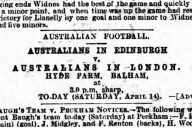You’re the biggest act in town, so you’re entitled to a bit of hubris. Your policy of ground rationalisation at the end of the 20th century transformed a game that was primarily played in the suburbs into a two-ringed circus played in the bright lights of the city.
Why go to the pictures, or a musical, when you can go to the footy. The AFL. It’s not just a sport, it’s entertainment.
And boy did they come, as the folk of Melbourne exchanged over a century’s worth of passion and suburban tribalism, developed on the rough and tumble of the terraces to take their seats in majestic modern sporting theatres.
At the end of the 2008 home and away season, for the first time in AFL history, over 4 million spectators, at an astonishing average attendance of 43,533, piled through the AFL box-office for the 92 productions hosted at Docklands Stadium and the MCG. A feat repeated in 2010 and 2011, and almost repeated in 2009.
But this wasn’t enough for Andrew Demetriou and his AFL cohorts. This was the real world. They just couldn’t go up to Mammon ladling moolah out of the money pot and plaintively ask “please sir, I want some more.”
So, they set about this task with great ardour. They expanded the competition by adding two new teams, to not only spread the gospel of AFL in pagan sporting lands, but to also add value to their super lucrative television deal by adding 22 more fixtures to broadcast.
But this wasn’t enough for the AFL. They had a product which turned Melburnians into lemmings. A town full of football junkies that would gladly sell their grandmothers in order to watch their beloved teams. Heck, they would even turn up in the middle of the night to watch them play.
For 2014, in a move which utterly demonstrated their disconnect with the great unwashed, the AFL executives in their ivory tower introduced a variable pricing model which made it prohibitively expensive to attend games involving the bigger drawing teams. No longer was it just enough to shell out in the great Victorian tradition of buying a membership to see your team play, you were now gouged by the AFL and the ticketing agency.
To make matters worse, they also scheduled matches to be played in times completely unfamiliar with the predictable habits of Melburnians…like Sunday night.
Let’s see how they got along.
By the end of the 2014 home and away season the attendance figure tallied up to a pretty sorry looking 3,467,314 for the 93 matches hosted in Melbourne, at an average of 37,282.
In 2013, 3,812,992 attended the 93 home and away matches in Melbourne at an average of 40,999. A drop of 9% in just one season.
The last time fewer Melburnians turned up to watch AFL matches was in 2004 when capacity at the MCG was significantly restricted due to construction of MCC Members, Olympic & Ponsford Stands. Even in 2005, when capacity was still restricted (sold out Anzac Day crowd of only 70,033) more people turned up than this season.
AFL Attendances in Melbourne 2004 - 2014
| Year | Attendance | Games | Ave. Crowd |
|---|---|---|---|
| 2004* | 3272372 | 92 | 35569 |
| 2005* | 3562119 | 92 | 38718 |
| 2006 | 3505766 | 89 | 39309 |
| 2007 | 3797619 | 91 | 41732 |
| 2008 | 4005039 | 92 | 43533 |
| 2009 | 3959957 | 92 | 43043 |
| 2010 | 4122879 | 96 | 42946 |
| 2011 | 4112300 | 95 | 43287 |
| 2012 | 3823832 | 94 | 40679 |
| 2013 | 3812992 | 93 | 40999 |
| 2014 | 3467314 | 93 | 37282 |
* MCG capacity restricted due to construction of stands
In simple arithmetic terms, the AFL has lost over half a million bums on seats in Melbourne in the last few years.
On June 29, during the diabolically scheduled Sunday night match between Collingwood v Carlton, the AFL’s clusterfuck finally came home to roost when the MCG scoreboard posted the pitiful crowd number of 40,939. It was bad enough when the two teams met earlier in the season in the marquee Friday night slot when “only” 68,251 turned up.
In 2013, this blockbuster fixture attracted huge crowds of 84,247 and 78,224.
First the fans were priced out and then they were scheduled out. They resoundingly voted with their feet.
How the fixture designed for TV didn’t increase viewing figures
Collingwood CEO Gary Pert CEO on the hijacking of the fixture to cater for broadcasters:
“The fixture was taken away from the best interests of the supporters and the clubs themselves. When we got the draft fixture at the start of the year, we said ‘this is a broadcast fixture’.”
“We called the broadcasters and they were open and honest about it. They said ‘we’d been pushing the AFL to put Collingwood games at times when Collingwood supporters don’t want to go to the games with their families so they’ll stay home and watch it’.”
The AFL’s calculated gamble to boost television ratings with a broadcaster-friendly fixture backfired as it had no real affect on viewing figures, especially in Melbourne. Just because AFL fans weren’t turning up to games didn’t necessarily mean more were switching on their televisions. Foxtel’s national average audience spread over the 198 home and away matches played in 2014 was 191,400 compared to 190,900 last year. And according to my calculations, Channel 7’s combined Melbourne viewership figures for the 88 games they televised this year is down 2.5% compared to 2013. (TV ratings sourced from Mediaweek)
Meanwhile, the unconscionability of the AFL ticketing rort did not pass unheeded.
On August 28, The Australian Competition and Consumer Commission (ACCC) put out the following press release:
The Australian Competition and Consumer Commission has warned the Australian Football League (AFL) and a number of AFL clubs about their failure, in the ACCC’s view, to adequately disclose to consumers that attendance at certain high demand games would incur costs in addition to membership fees.
In fact, AFL members and general admission AFL club members were required to pay additional costs in order to attend ‘reserve’ classified games that had originally been promoted as part of their membership entitlements. The additional costs were between $8.50 and $39 for general admission AFL club members and $7.50 for AFL members.
Following public reports and the ACCC’s intervention, the AFL removed all reserve classified games from Round 15 onwards, so that these additional costs were no longer charged.
With Melbourne’s population bursting through the 4 million barrier as the city’s growth continues unabated at a rollicking pace, the question to be asked is if or when the 4 million spectator mark will ever be broken again in a Melbourne home and away AFL season.
Andrew Demetriou’s replacement as AFL CEO, a penitent Gillon McLachlan, has vowed to get Melbourne’s wandering fans to flock back to AFL church by producing the people’s fixture in 2015.
“Now in hindsight, the AFL is saying they’ll change those fixturing decisions and make it a lot more about the supporters,” said Magpies CEO, Gary Pert.
As the AFL found out in Melbourne this season, when a sport stops being mainly about the supporters, the supporters will stop turning up and one day might even tune out.

















Athas, good post.
There is another element to attendances too, that underscores the drop from 2010. AFL attendances have always been artificially bolstered by the large number of derby games. The 90 odd games played in Melbourne cater for not only the home team, but as often as not, the nominal away team, where 20,000 supporters becomes a crowd of 40,000.
In 2010, the total number of Melbourne home games was 151. In 2014, with the addition of GWS and Gold Coast, it is down to 139. A 10% increase in TV product for an 8% expense in local opportunities for Melbourne based fans to see their club. Perhaps the price of developing a truly national competition, but it isn’t a small one to pay.
Thanks for the comment, Russ.
Yes, the stats do reflect this. The entrance of Gold Coast & GWS resulted in a reduction of Melbourne derbies and a drop in average attendances to 40,679 & 40,999 in the 2012 & 2013 seasons. However, the significant 9% drop this season to 37282 can only be attributed to exorbitant pricing & broadcast friendly scheduling.